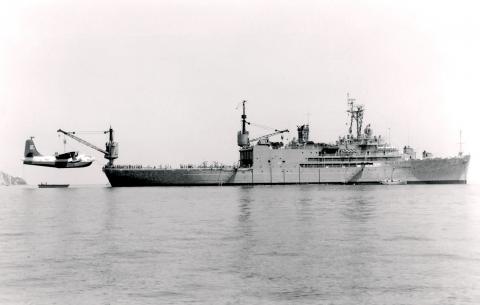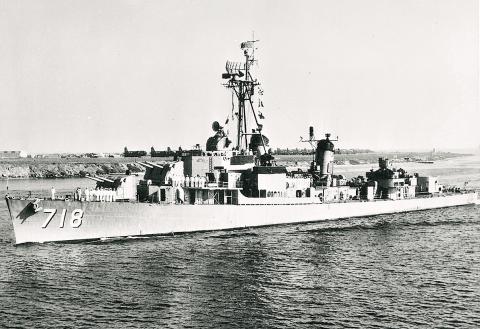Taiwan in Time: Jan. 25 to Jan. 31
All had been calm on the Taiwan Strait for about three years since the Taiwan Patrol Force, formed by destroyers from the US Navy’s Seventh Fleet, entered the strait in 1950 to prevent both sides from attacking each other.

Photo courtesy of Wikimedia Commons
It wasn’t easy patrolling the strait due to rough seas and unstable, harsh weather which often brought strong winds, monsoons and typhoons. The geography of the strait would often exacerbate the storms hitting the destroyers sailing up and down the narrow body of water.
“Since the primary goal was to deter invasion from either side, the patrols often had the appearance of steaming up and down aimlessly,” Bruce Elleman writes in the book High Seas Buffer. “However, success was measured by what did not happen — no news was good news.”
This passage symbolized the US’ position toward the cross-strait conflict between the Chinese Nationalist Party (KMT) and the Chinese Communist Party (CCP), which had just parted ways in 1949 after the Chinese Civil War.

Photo courtesy of Wikimedia Commons
But the no-news period didn’t last long. Hostilities resumed on several islands off China’s coast in 1953 after the lifting of the blockade, leading to the KMT losing two islands, the signing of the Sino-American Mutual Defense Treaty in December and passing of the Formosa Resolution on Jan. 29, 1955, setting the tone of events in decades to come.
Prior to the Korean War in 1950, US President Harry S. Truman had maintained that his country would stay out of any KMT-CCP disputes. But he changed his mind later and decided on the “neutralization of the Taiwan Strait,” not only because of the US’ anti-communist policy but also because of Taiwan’s strategic location in the supply line for US troops in Korea.
“In these circumstances the occupation of Formosa by Communist forces would be a direct threat to the security of the Pacific area and to United States forces performing their lawful and necessary functions in that area. Accordingly, I have ordered the 7th Fleet to prevent any attack on Formosa,” he declared.
Elleman writes that it also carried the purpose of preventing the KMT from any armed activity against China.
As a result, an anticipated invasion of Taiwan never happened, even though the patrol was mostly symbolic and carried little military value.
“Two (destroyer escorts) with two three-inch guns apiece did not constitute much of a military presence, but as a symbol of commitment the patrol definitely had value,” James Barber, a former patrol force member, says.
This naval blockade was lifted in February 1953 near the conclusion of the Korean War, when new president Dwight Eisenhower responded to calls from right-wing politicians to “unleash [KMT leader] Chiang Kai-shek (蔣介石)” on the Chinese communists. Cold war historian Haruka Matsumoto writes in a study that Chiang was “rejuvenated” by the decision and began making concrete plans to retake China.
The KMT launched a failed invasion of one of China’s offshore islands it previously held and later moved large numbers of soldiers to the offshore islands of Kinmen and Matsu while the People’s Republic of China amassed troops of its own. This led to the First Taiwan Strait Crisis, when then-Chinese premier Zhou Enlai (周恩來) called for the liberation of Taiwan in August 1954 and the People’s Liberation Army began bombing Kinmen a month later despite US warnings.
In December, the KMT and the US agreed to the Mutual Defense Treaty, in which only Taiwan and Penghu were mentioned, not the offshore islands. The US’ goal for the treaty, Matsumoto writes, was to prevent any attack from both sides of the Taiwan Strait so it wouldn’t have to directly fight China or possibly the Soviet Union.
Fighting intensified as the communists took Yijiangshan Island (一江山) on Jan. 18, 1955, and launched an attack on Dachen Island (大陳) the next day. The US, having promised to defend Taiwan and Penghu, reportedly saw these offshore islands as of little strategic value and not worth triggering a war with China. It eventually convinced a reluctant Chiang to evacuate the islands, and passed the Formosa Resolution on Jan. 29, which authorized Eisenhower to use force for the “specific purpose of securing and protecting Formosa and the Pescadores against armed attack” as well as “related positions and territories of that area now under friendly hands.”
Like the patrol, Matsumoto writes that this act was meant to intimidate the communists into inaction by officially signifying the US’s willingness to use force.
The patrol and the USS Midway helped with the evacuation of Dachen, which was completed on Feb. 12.
The US further tried to convince Chiang to abandon the remaining islands of Kinmen and Matsu in exchange for extra reinforcements in Taiwan, but Chiang refused. However, with the Soviet Union appearing unwilling to help the CCP in their cause, and Eisenhower making thinly-veiled nuclear threats, the communists stated on April that year that they were willing to negotiate the status of Taiwan, stopping all hostilities on May 1.
Peace would only last for three years, as violence flared up again three years later in the second Taiwan Strait crisis.
Taiwan in Time, a column about Taiwan’s history that is published every Sunday, spotlights important or interesting events around the nation that have anniversaries this week.

In the March 9 edition of the Taipei Times a piece by Ninon Godefroy ran with the headine “The quiet, gentle rhythm of Taiwan.” It started with the line “Taiwan is a small, humble place. There is no Eiffel Tower, no pyramids — no singular attraction that draws the world’s attention.” I laughed out loud at that. This was out of no disrespect for the author or the piece, which made some interesting analogies and good points about how both Din Tai Fung’s and Taiwan Semiconductor Manufacturing Co’s (TSMC, 台積電) meticulous attention to detail and quality are not quite up to

April 21 to April 27 Hsieh Er’s (謝娥) political fortunes were rising fast after she got out of jail and joined the Chinese Nationalist Party (KMT) in December 1945. Not only did she hold key positions in various committees, she was elected the only woman on the Taipei City Council and headed to Nanjing in 1946 as the sole Taiwanese female representative to the National Constituent Assembly. With the support of first lady Soong May-ling (宋美齡), she started the Taipei Women’s Association and Taiwan Provincial Women’s Association, where she

It is one of the more remarkable facts of Taiwan history that it was never occupied or claimed by any of the numerous kingdoms of southern China — Han or otherwise — that lay just across the water from it. None of their brilliant ministers ever discovered that Taiwan was a “core interest” of the state whose annexation was “inevitable.” As Paul Kua notes in an excellent monograph laying out how the Portuguese gave Taiwan the name “Formosa,” the first Europeans to express an interest in occupying Taiwan were the Spanish. Tonio Andrade in his seminal work, How Taiwan Became Chinese,

Mongolian influencer Anudari Daarya looks effortlessly glamorous and carefree in her social media posts — but the classically trained pianist’s road to acceptance as a transgender artist has been anything but easy. She is one of a growing number of Mongolian LGBTQ youth challenging stereotypes and fighting for acceptance through media representation in the socially conservative country. LGBTQ Mongolians often hide their identities from their employers and colleagues for fear of discrimination, with a survey by the non-profit LGBT Centre Mongolia showing that only 20 percent of people felt comfortable coming out at work. Daarya, 25, said she has faced discrimination since she